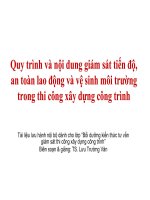BÀI GIẢNG QUY TRÌNH TRONG HÀNG KHÔNG
Bạn đang xem bản rút gọn của tài liệu. Xem và tải ngay bản đầy đủ của tài liệu tại đây (2.15 MB, 20 trang )
Procedure of Initial Sizing
Design Criteria
Initial Sizing
Design Criteria – Upper Skin Panel
No local buckling up to ultimate load. They shall be sized using compression
and shear interaction criteria:
σ c τ s2
+ 2 ≤ 1.0
σ cr τ cr
σ c = applied compression stress
σ all = allowable compression stress of the panel, which is the smallest value
of :
crippling stress
skin local buckling stress
intermediate (Johnson Euler) column buckling stress
τ s = applied shear stress
τ all = allowable shear stress of the panel, which is the smallest value of :
skin shear local buckling stress
allowable shear stress of the material used
Design Criteria – Lower Skin Panel
shall be sized using tension and shear interaction criteria:
σ all
≥ 1.0
σ comb
where as material failure according to Von Mises :
σ comb = σ t + 3τ 2
σ all
σt
τs
= allowable tension stress of the material used
= applied tension stress
= applied shear stress
Please note that Lower panel is also critical due to fatigue. The
criteria have to be considered is :
σ all −1G
− 1 ≥ 0.0
σt
Design Criteria – Spars
They shall be sized using shear criteria :
τs
τ all
≥ 1.0
τ s shear stress
= applied
τ all = allowable shear stress of the panel, which is the
smallest value of:
skin shear local buckling stress
allowable shear stress of the material used
Design Criteria – Ribs
Due to concentrated loads (attachments: engine, flaps, etc):
Due to shear loads : Due to aerodynamic loads, the ribs shall be designed
as beams simply supported at the spars. The web shall be sized
using shear criteria :
τ s = applied shear stress
τ all
≥ 1 .0
τs
τ all = allowable shear stress of the panel, which is the smallest value of:
skin shear local buckling stress
allowable shear stress of the material used
Design Criteria – Ribs Cont.
Due to crushing loads : The stiffener shall be sized using
compression criteria :
σ all
≥ 1.0
σ
σ all = allowable compression stress of the panel, which is the smallest
value of :
Column buckling stress
Allowable compression stress of the material
σ = applied compression stress
Initial Sizing: Upper and Lower Skin Panel
i.
ii.
iii.
iv.
At various points across the span evaluate the
idealised depth of the primary structural box, h
Calculate the effective direct loads, P, in the top
and bottom surfaces required to react the
appropriate bending moment, M, at each
section from: P = M/h
Evaluate the allowable stress, fb
Evaluate the cross section area required, Ab by
dividing the load P by the allowable stress fb
Initial Sizing: Upper and Lower Skin Panel
Initial Sizing: Upper and Lower Skin Panel
For a mass boom design, where all the bending moment is
reached only by the spar caps:
P M
Ab =
=
f b hf b
Initially assume Ab is divided equally between all the boom spar
caps on one side of the box, and fb is the allowable proof stress
in this case.
Initial Sizing: Upper and Lower Skin Panel
For a distributed flange assume initially a uniform effective
thickness across the width, w, to give
M
te =
hwf b
Typically this thickness will be made up of skin and stringer
area. The effective stringer are being about half of that of the
skin area. Thus the actual skin thickness is about:
0.65M
te =
hwf b
Allowable Stresses - Direct (bending)
Stress
The accurate evaluation of the allowable bending stress is
complex, requiring a knowledge of the detail features of the
structure both in the compression and tension surfaces.
Experience suggests that if the magnitude of the allowable
compression stress is also used for the tension surface it
makes the right order of allowance for fatigue/crack
propagation requirements although this assumption can
only be approximate, especially when the allowable
compression stress approaches the 0.2% proof value. Thus
the same allowable stress level may be initially assumed in
both surfaces. The main parameter in determining the
allowable compression stress is the loading intensity.
If mass booms are used as the primary means of reacting
direct load, then it is appropriate to assume that under
ultimate bending loads the 0.2% proof stress may be used.
Allowable Stresses - Direct (bending)
Stress
When the concept is based on a distributed flange
construction the allowable bending stress at ultimate loading
may be assumed to be the lesser of the 0.2% proof stress or f b,
where fb may be approximately represented by:
1/ 2
P
f b = A FB
wL
where L is the local rib or frame spacing
w is the width of the box perpendicular to the bending axis
P is the effective end load
A is a function of the material
FB is dependant upon the form of construction.
Note that the value of A are
appropriate to allowable stress
and (P/wL) in MN/m2 units. In
general the values of A give
conservative values for Fb at
stresses below the limiting
value.
Typical values for FB are also
given.
Initial Sizing: Spar Webs
i.
Due to Overall Torsion Moment:
Estimate the enclosed area, A, of the primary structural box
at representative sections across the span.
The corresponding shear flow is:
QT = T/2A
Where T is now the applied distributed torsion, and QT will be
nose up or nose down and hence positive or negative
depending on the sign convention
Select the allowable shear stress, fs as appropriate
The mean material thickness needed to react the torsion
moment is then:
tq = T / 2Afs
Initial Sizing: Spar Webs
ii.
Combined with vertical shear loads
The shear flow in the webs due to the shear force is then:
Qv = V/hT,
where V is the applied vertical shear force
The net shear flow in the web is then approximately given by:
x
Qw = QV + 2 QT
w
Where x is the chordwise location of particular web relative to
the mid point of the box
The web thickness is then:
Qw
tw =
fs
Initial Sizing: Ribs Web
i.
Due to concentrated loads (attachments: engine, flaps,
etc): can be taken as a cantilever beam loaded by a vertical shear
force equal to the hinge reaction and a bending couple due to the
offset of the hinge chordwise from the rear spar location. The spar
web will react most of the vertical shear, and in practice if the hinge
fitting is perpendicular to the rear spar, the rib flanges at the spar
will be loaded by direct forces given by:
x
R = ±V .
h
Where V is the hinge reaction
x is the offset of the hinge from the spar
h is the depth of the rib at the spar
Initial Sizing: Ribs Web
ii.
Due to shear loads :
R = Q z1 − Q z 2
Initial Sizing: Ribs Web
Due to crushing loads :
iii.
σn =
Where:
σn
2.σ 2 .t panel .L
E.h.trib
= crushing stress at rib
;
L
= rib distance
σupper = normal stress at upper panel
;
H
= rib height
σlower = normal stress at lower panel ;
trib = rib web thickness
σ=
abs (σ upperpanel ) + abs (σ lowerpanel )
2









